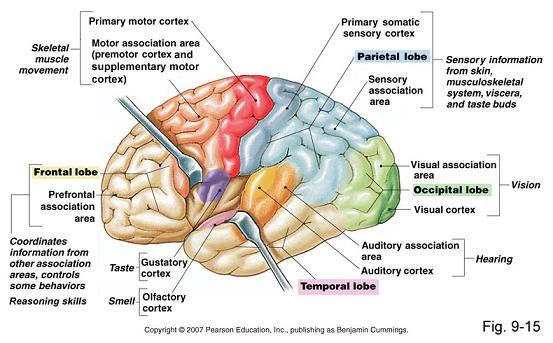Cerebral Cortex
A Cerebral Cortex is a mammalian brain structure that forms its outer layer.
- Context:
- It can (typically) contain a Frontal Cortex, Temporal Lobe, Parietal Lobe, Occipital Lobe.
- It can (typically) be composed of a Right Cerebral Cortex and a Left Cerebral Cortex.
- …
- Example(s):
- Human Cortex.
- …
- Counter-Example(s):
- See: Golgi's Method, Cerebrum, Neural Tissue, Sagittal Plane, Cerebral Hemispheres, Medial Longitudinal Fissure.
References
2016
- (Wikipedia, 2016) ⇒ http://wikipedia.org/wiki/cerebral_cortex Retrieved:2016-1-29.
- The cerebral cortex is the cerebrum's (brain) outer layer of neural tissue in humans and other mammals. It is divided into two cortices, along the sagittal plane: the left and right cerebral hemispheres divided by the medial longitudinal fissure. The cerebral cortex plays a key role in memory, attention, perception, awareness, thought, language, and consciousness. The human cerebral cortex is thick.
In large mammals, the cerebral cortex is folded, giving a much greater surface area in the confined volume of the skull. A fold or ridge in the cortex is termed a gyrus (plural gyri) and a groove or fissure is termed a sulcus (plural sulci). In the human brain more than two-thirds of the cerebral cortex is buried in the sulci.
The cerebral cortex is gray matter, consisting mainly of cell bodies (with astrocytes being the most abundant cell type in the cortex as well as the human brain as a whole) and capillaries. It contrasts with the underlying white matter, consisting mainly of the white myelinated sheaths of neuronal axons. The phylogenetically most recent part of the cerebral cortex, the neocortex (also called isocortex), is differentiated into six horizontal layers; the more ancient part of the cerebral cortex, the hippocampus, has at most three cellular layers. Neurons in various layers connect vertically to form small microcircuits, called cortical columns. Different neocortical regions known as Brodmann areas are distinguished by variations in their cytoarchitectonics (histological structure) and functional roles in sensation, cognition and behavior.
- The cerebral cortex is the cerebrum's (brain) outer layer of neural tissue in humans and other mammals. It is divided into two cortices, along the sagittal plane: the left and right cerebral hemispheres divided by the medial longitudinal fissure. The cerebral cortex plays a key role in memory, attention, perception, awareness, thought, language, and consciousness. The human cerebral cortex is thick.
